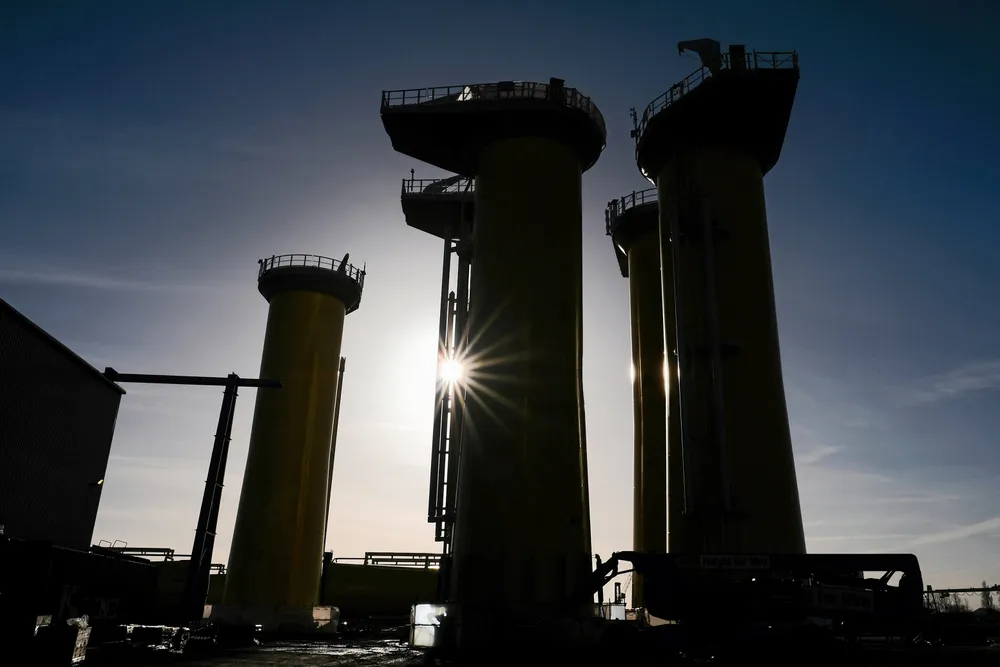UK 'needs $26bn-worth of steel' for offshore wind
Nation's sector will require 25 million tonnes of steel in the second quarter of this century, says study, as trade body urges measures to drive up local content

An independent study has found that up to 25 million tonnes of steel will be needed to build Britain's offshore wind infrastructure in the second quarter of this century as trade body UK Steel called for more to be done to make sure those orders are sourced domestically.
In a statement released today (Tuesday), UK Steel said its own report — which included the independent findings on offshore wind — featured proposals “to improve the uptake of UK-made steel in taxpayer-funded projects”.
Proposals highlighted ways for the government, as the UK's single biggest purchaser of steel, to drive up procurement from domestic steelmakers rather than buying from overseas.
To highlight the opportunities, UK Steel commissioned advisory firm LumenEE to identify the total volume of steel needed for the rapid expansion of the UK’s offshore wind sector.
The findings were described by UK Steel as "an opportunity... worth approximately £21bn ($26bn) in steel purchases”.
The LumenEE study found that the UK’s offshore wind pipeline had a steel demand of 1.1 million tonnes in 2023 but noted that "the vast majority" of steel continues to be provided by non-UK mills, partly because "components for the UK’s offshore wind pipeline are being fabricated abroad and then imported".
The study found that less than 2% of UK steel components needed in the last five years, in terms of weight, were fabricated in the UK.
"The UK has had some success securing some components fabrication, but activity in the UK is primarily for fit-out and finishing of components using imported primary subcomponents and secondary components," LumenEE stated.
While new plants, such as SeAH Wind’s £900m Teesside monopile manufacturing facility, will ensure rolling of large plate and fabrication of large monopiles continues within the UK, the study suggested that demand for larger plate sizes means that SeAH will need to import steel for its production.
The study showed steel-makings segments where the UK has capacity and expertise, such as rebar and tensioning strands, secondary steel and specialist components, but also highlighted opportunities for development, given the size of the UK offshore wind pipeline.
Opportunities were identified for new welding technologies and new caster and plate rolling capacity to supply plate into the offshore wind market, in step with other strategic sectors such as defence.
"The UK would need to move swiftly to build out new mill capacity to be ready to supply this market," LumenEE observed.
Massive opportunities
The UK Steel report said offshore wind provides a case study to show “the massive opportunities for the UK industry across the wide metals supply chain if there was a supportive procurement policy environment”.
“Over the next decade, government steel requirements will exceed £4.3bn without even accounting for major initiatives such as carbon capture and storage, hydrogen infrastructure, nuclear energy, and offshore wind,” the trade body claimed.
Identifying offshore wind as a prominent opportunity to apply such policies, UK Steel urged the UK government to build such demand projections into a growth strategy being prepared for the steel sector.
“Data gaps should be filled to better plan for projected demand in other key markets and evaluate disparities in national steelmaking capacity and capability to meet these needs,” the report added.
"Better data and a full understanding of the challenge will shape the much-anticipated government steel strategy and ensure the government can strategically invest its £2.5bn National Wealth Fund share earmarked for our sector”.
According to UK Steel, one third of the steel procured by the British government is currently imported.
The report set out five key recommendations to ensure that, “where reasonably possible, steel made here in the UK stands at the front of the queue when government is making purchasing decisions on steel.”
These recommendations included:
- Applying World Trade Organisation opt-outs to mandate or incentivise the use of UK-made steel for projects of energy, defence, and related infrastructure. This recommendation is framed to cover domestic content stipulations in public procurement contracts with public funding or subsidy, based on recognition of the contribution that a domestic steel industry makes to national security.
- For Contract for Difference (CfD) tenders, the government was urged to evaluate bidders’ contributions to sustainability, resilience and local content, with these criteria applying to at least 30% of the volume auctioned annually, mirroring some of the measures the European Union is currently implementing in its Net Zero Industry Act.
- Nationally Significant Infrastructure Projects should be required to adhere fully to the Procurement Policy Note for Steel and, given their criticality, made subject to local content requirements of not below 30%.
- The existing Procurement Policy Note for Steel should be strengthened to require developers and public bodies to justify why they did not use UK-made steel, if available.
- A public-private partnership should drive investment into steel supply chains which attract inward investment "and ensure the UK develops resilient supply chains in the face of uncertain geopolitics".
Commenting on the report UK Steel director-general, Gareth Stace, said: “The UK steel sector stands ready to partner with the government to build a strong steel strategy that prioritises homegrown production.
“The LumenEE findings on offshore wind alone illustrate what’s at stake: £21bn in steel purchases that could drive a major upturn in UK production. Without decisive action, we risk losing this opportunity and continuing to fund foreign competitors instead of our own economy."
(Copyright)